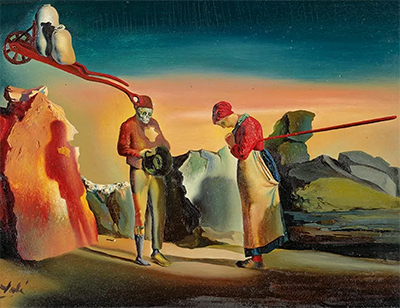The two figures are dressed in traditional clothing and placed centrally amidst a bright landscape with a small building to the left. The sun envelopes the scene in light from the right hand side, as we view the painting, and shadows are case on the alternative side of the artwork. The furthest tips are dark, both at the top and bottom of the canvas and everything inbetween is warmly coloured in line with the artist's upbringing in Figueras, Northern Spain. There are also a stack of rocks which set the scene of this desert-like, dry landscape of which Dali was so familiar. As we learn from the title, this is twilight, hence these colour balances.
What we see here is a couple during evening prayers. It is a direct connection to Millet's Angelus painting, and Dali would produce a multitude of works inspired by this iconic artwork. He is known to have studied and appreciated many masters from previous centuries, including Spanish painters such as Goya and Zurbaran. Millet arrived much later but played a role in promoting landscape art and also drawing attention to the lives of the working poor, similar to the impact made by Gustave Courbet. Dali used different movements within his career and so it is unsurprising that he also appreciated different art movements from the past, including the Renaissance and also, in the case of Millet, the Barbizon School.
This artwork is dated from 1933 and illustrates how the artist would take iconic scenes from the past and drop them directly into his fantastical, surrealist world. He revisited this Millet painting for inspiration on a number of occasions during this period of his career. The original artwork can now be found at the Kunstmuseum Bern, alongside other notable paintings from artists such as Duccio, Fra Angelico, Paul Klee, Wassily Kandinsky and Pablo Picasso. The collection covers a great breadth of European art since the early stages of the Renaissance up to the 20th century and is amongst the finest galleries in Switzerland.

